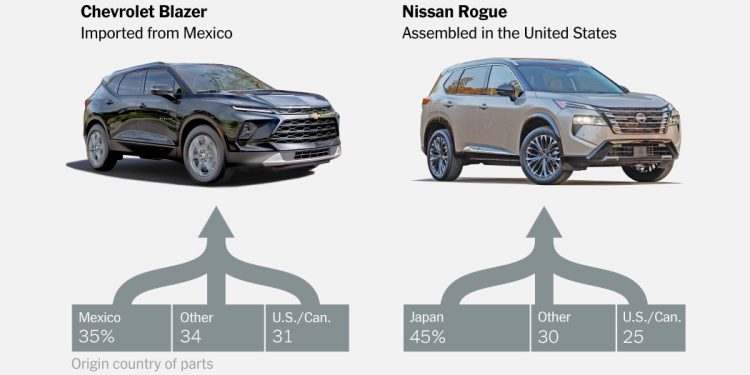The 25% prices of President Trump on the goods of Canada and Mexico could be particularly felt acute by car manufacturers – and car buyers – due to the number of vehicles and parts that enter the United States every day when they go to the market.
Over the past three decades, since the creation of the North American free trade area in 1994, car manufacturers have built supply chains that cross borders.
Imports of American cars by country since 1989
Manufacturers reach scale savings by construction engines and transmission factories that are large enough to provide a number of vehicle factories in North America. A similar reflection also works for other parts – seats, instrument catches, electronics, axles.
“This exploits the strength of each country, to improve businesses and consumer,” said Sam Fiorani, Vice-President of Autoforecast Solutions, a research company. “Vehicles would be less affordable if all the parts were to be made in a country.”
In the end, a vehicle is considered an import when it is dispatched to the United States after having undergone a final meeting in another country. But due to the way in which the supply chains have become, it is increasingly difficult to say which vehicles are made in the United States and which are imported.
The Chevrolet Blazer 2024, a popular sports utility vehicle made by General Motors, is assembled in a Mexico factory using engines and transmissions produced in the United States.
Nissan manufactures his Altima sedan in Tennessee and Mississippi; The turbocharged version of the car has a two -liter engine from Japan and a transmission made in a factory in Canada.
Then there is the Toyota Rav4. Most RAV4s sold in the United States are made in Canada. Canadian manufacturing models use engines and transmissions built in the United States and shipped north-before completed vehicles were transported to the United States for sale.
The Trump administration has not yet explained how prices would be applied to components such as engines that have been shipped through the border, and then returned to the United States as part of completed vehicles.
While the RAV4 is technically imported from Canada, around 70% of the vehicle components – as measured by their value – come from the United States, according to the National Highway Traffic Safety Administration, which follows the place or the origin of the parts that go to the vehicles sold here.
The Nissan Rogue SUV goes in the other direction. It is considered a vehicle produced in the country because it is assembled at the Nissan factory in Smyrna, tenn. But only 25% of its content comes from the United States. The engine of the 2024 version comes from Japan and its transmission from Mexico, according to data from the road safety agency.
Where does American imported cars come from in 2023
The threat of prices means that car manufacturers have worried. “Let’s be really honest,” said Ford Motor’s general manager Jim Farley, at a conference on investors in February. “In the long term, a price of 25% through the borders of Mexico and Canada would make a hole in American industry that we have never seen.”
On Wednesday, Stellantis president John Elkann said that his company had supported Trump’s desire to promote American manufacturing, but added that the company – whose brands include Chrysler and Jeep – believed that trade with Mexico and Canada should remain “without tariff”.
Number of cars produced in America from any brand
Over the past 20 years, the number of imported vehicles sold in the United States has remained relatively constant, with hollows caused by the 2008-9 financial crisis and the coronavirus pandemic. The biggest source is Mexico, closely followed by Japan, South Korea and Canada.
Meanwhile, the number of cars produced in the United States has fluctuated. Interior production exceeded 12 million vehicles in 1999, but this figure dropped during the recession. Since then, the industry has shown a solid rebound because fuel prices have stabilized and consumer confidence has returned, although production volumes have never completely found the figures observed in the early 2000s.
For many consumers, from where their car is not very concerned. Frank Krieber, a Charlotte retirement technology manager, NC, bought a Chevrolet Tahoe a few months ago. He assumed that it was an American vehicle – and indeed, he is assembled in Arlington, Texas. But just over a third of its parts are manufactured in the United States, and almost the same amount comes from Mexico, according to the National Highway Traffic Safety Administration.
“I don’t mind the Mexican content,” said Krieber. “If he was made in Mexico instead of Texas, I would always have bought it.”


